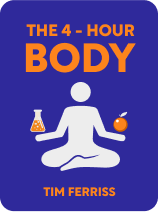

This article is an excerpt from the Shortform book guide to "The 4-Hour Body" by Timothy Ferriss. Shortform has the world's best summaries and analyses of books you should be reading.
Like this article? Sign up for a free trial here .
How can you become a better sprinter? What are Tim Ferriss’s tips for becoming a great sprinter?
In The 4-Hour Body, author Tim Ferriss trained with top athletes and coaches to understand performance science applied to his body. He learned some tips for sprinting during one of his endeavors.
Read on for some tips for sprinting Tim Ferriss learned.
Training Tips for Sprinting
Now that we understand the value of strength training for athletes, it’s time to look at training for specific sports. First, we’ll look at tips for sprinting. The author spoke with two different experts about how to increase sprinting prowess: Barry Ross, who coaches track athletes, and Joe DeFranco, who teaches football players how to ace the physical tests in the NFL Combine, part of the tryout and drafting process.
Barry Ross and Track and Field
Barry Ross is the expert coach who trained Olympian Allyson Felix. He spends a lot of time developing his athletes’ strength—most of his trainees can lift more than double their body weight, and they achieved these results in fewer than 15 minutes of lifting time a week. Among the tips for sprinting, strength is important because athletes slow down when their muscle fibers aren’t strong enough to maintain tension during impact, such as when a runner’s foot hits the ground. (Previously, coaches believed that athletes slowed down because muscles ran out of fuel.)
Ross uses a three-step process to train his athletes, and you can use the process too:
Step #1: Get in Shape
You need to be able to run a 100-meter dash in less than 23.8 seconds before you can start training to compete. To get to this baseline, walk 7.5 minutes in one direction and then walk back to your starting point in another 7.5 minutes. Walk as fast as you can—it should feel inefficient and you should want to switch to jogging (but don’t). Do this three times a week, and each time, walk farther. It will take about four weeks to get in shape and be capable of running the 100-meter in the required time.
Step #2: Get Stronger
Once you’re in shape, to build strength, follow this program three times a week (an earlier version of which Allyson Felix used):
Exercise #1: 6-7 reps of over-under dynamic stretching. Using two power racks, set one bar at waist height and the other at 30-32 inches off the ground. Squat and step sideways under the lower bar and then step over the second one. If you don’t have access to a power rack, use benches or ropes. This exercise should take less than five minutes.
Exercise #2: Do either 10-12 push-ups OR the following bench press sequence:
- One set of 2-3 reps of bench presses. (The weight should be 95% of the heaviest weight you can lift once (one repetition max, or 1RM) To estimate, multiply your 5-rep maximum by 1.2.)
- 4-5 bench-press plyometrics. To do this, find two boxes that are between 6 and 12 inches high and put them outside your shoulder width. Do a push-up between them, and when you’re at the bottom of your push-up, push off your arms and jump them onto the boxes. Jump back down to the fully-lowered position. As soon as you land, take off again—the landing phase should be as short as possible.
- Five minutes rest.
- One set of bench presses with 5 reps at 85% 1RM.
- 4-5 bench-press plyometrics.
Exercise #3: Deadlifts sequence. To deadlift, use a sumo stance. Keep your back straight and keep your shoulders in the locked position. After lifting to knee height, drop the weight instead of lowering it to avoid hamstring injuries (if you’re not also training sprinting, which involves a lot of hamstrings, it’s fine to lower the weight). You shouldn’t spend more than 10 seconds under tension—spending any longer leads to lactic acid production, which creates muscle soreness. Do the following sequence:
- One set of 2-3 reps at 95% of your 1RM.
- Plyometrics. Ideally, sprint 10-15 meters for 2-4 reps. The next best option is to jump onto a 12-18-inch box for 5-7 reps. As soon as you land, take off again—the landing phase should be as short as possible.
- Five minutes of rest.
- One set of deadlifts with 5 reps at 85% 1RM.
- Another set of plyometrics.
Exercise #4: 3 sets of 3 reps of the torture twist. Sit on a bench and tuck your feet under a bar or another bench. Keep your body parallel to the ground. Turn to your left and stay there for three seconds. Then turn to your right and stay there for three seconds. That’s one rep. After each set, sit up and take a 30-second rest. As you improve, you can increase to 5 reps and increase your holding time to 15 seconds.
You can lift and then go directly to running practice, but don’t run and then lift—you might injure yourself.
Step #3: Get Faster
Tips for sprinting speed:
- Measure your baseline with two time trials:
- Run 40 meters but only time the last 20 meters.
- Run 305 meters and only time the last 300 meters.
- Enter your times into the Anaerobic Speed Reserve (ASR) algorithm. This algorithm predicts how fast you should be able to run any distance and will give you goal times.
- Choose a random distance between 15-55 meters and get the corresponding time from the algorithm.
- Run the distance in under the algorithm’s time.
- Rest four minutes.
- Continue running the distance and resting for four minutes. Stop when you can no longer make the time or when you hit 10 reps. If you can’t make the time on the very first attempt, you can try once more.
This is a departure from conventional sprint training, which usually suggests you run the distance you’ll be racing multiple times at different percentages of your maximum speed. This technique isn’t effective because no one knows the exact percentage of effort or speed they’re using.
Conventional running training also recommends running longer than you’ll have to in a race to improve your endurance, but Ross doesn’t recommend this. None of his athletes who compete at 400m or less ever run a training distance of more than 70 meters, and this doesn’t hurt their performance at all—his athletes do very well. For example, using the training, one of his 100-meter sprinters reduced her time from 13.35 seconds to 12.75 seconds.
Joe DeFranco and the 40-Yard Dash
Like Ross, DeFranco has his athletes run shorter distances than they’ll ultimately need to run. In football, as part of NFL tryouts, hopefuls have to sprint a 40-yard dash. Joe DeFranco has his athletes spend 80% of their training time on 10-yard dashes. In addition to Ross’s reasons, DeFranco finds that practicing shorter distances is effective because it gives athletes more opportunity to practice their starting stance and experiment with posture and stride.
DeFranco’s method is effective—for example, Dallas Cowboys’ Miles Austin ran a time of 4.67 seconds in the 40-yard dash even though he’d only practiced that distance three times, and had practiced the 10-yard distance over 100 times.
With the help of DeFranco, the author improved his 40-yard speed from 5.94 seconds to 5.61 seconds using the following tips:
1. Wear cleats.
2. Warm up properly, using exercises that include the same postures and techniques required for a sprint:
- 2 sets of skipping for a 20-yard distance
- 6 reverse lunges on each side
- 2 sets of backward cycling (pretend you’re riding an invisible bicycle backward) for a 20-yard distance
- 2 sets of squatting side shuffle (squat partway down, facing sideways, and replace your front foot with your back foot) for a 20-yard distance
- 10 roll-backs into straddles
- 10 fire hydrants (Shortform note: The author doesn’t describe the movement or provide an image or video. You can view a generic version of the exercise here.)
- 10 mountain climbers (don’t ever put your heels on the ground)
- 20 seconds of pogo jumps (jump on the balls of your feet as fast as you can with your legs straight)
- 2 sets of five seconds of wide-outs
3. Use an effective starting position. If you’re right-handed, set up behind the line with your left foot a foot behind the line, and your right foot right behind your left heel. Your feet should be hip-width apart. Put the thumb, index, and middle finger of your right hand on the line. Put your weight on your right arm so that your shoulder is forward of your hand. Bend your left elbow at a 90-degree angle. Look at a spot on the ground three feet in front of your left foot and keep your head down. (If you’re left-handed, do everything opposite.)
4. Start with good technique. Your right arm shoots backward. Your first step is with your left leg and it should land on the spot you focused your gaze on in the previous step. Your knee should be forward of your toes when you land.
5. Maintain good form as you sprint. As you run, your upper body should always be forward of your lower body and your chin should be down (if it’s up, your feet hit the ground heel-first, which can injure the hamstrings). Use as few steps as possible.
Tips for Sprinting Without Hamstring Tears
Hamstring injuries are common in sprinting. There are some prehab exercises you can do to reduce your chance of injury:
- Practice the natural glute-ham raise.
- Strengthen your hip extension using hyperextensions, kettlebell swings, sled dragging, or supine hip thrusts.
- Stretch your hip flexors. If they’re tight, they constantly pull on your hamstrings.
If your hamstrings start to feel tight while training, they’re close to tearing, so stop your workout and rest. Don’t stretch (the muscle is already overstretched). Instead, ice the muscle and apply arnica montana.

———End of Preview———
Like what you just read? Read the rest of the world's best book summary and analysis of Timothy Ferriss's "The 4-Hour Body" at Shortform .
Here's what you'll find in our full The 4-Hour Body summary :
- How to do the least amount you need to do for the results you want
- Why you need a cheat day in your diet
- How to improve everything about your body, including sleep, sex, and longevity







You leave out the most important part of the speed factor, WHAT IS THE SPEED ALGORITHIM? Once I have my 20m time and my 300m time, than what ? What is the actual algorithim I “PLUG IT INTO”?